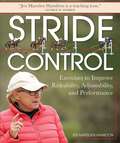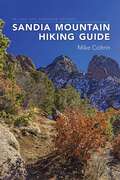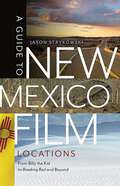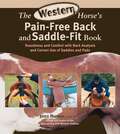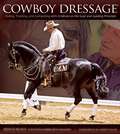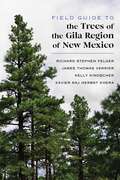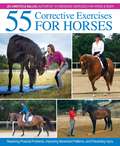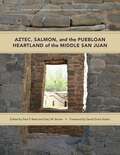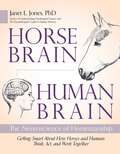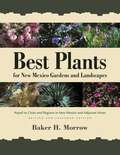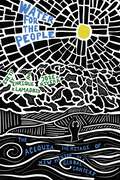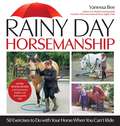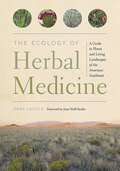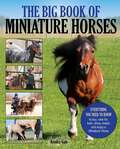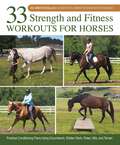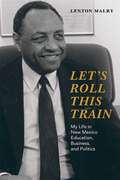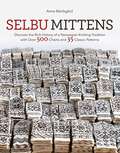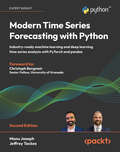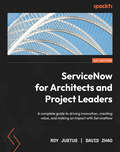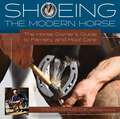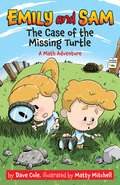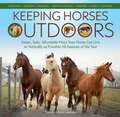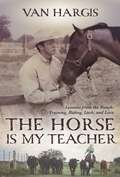- Table View
- List View
Stride Control
by Jen Marsden HamiltonStride control (striding) is an essential part of any rider&’s development when jumping obstacles, and jumping them well, is a goal. Understanding and implementing stride control (being able to adjust the number of strides before and between fences) improves a horse&’s rideability and allows the rider to further improve the horse&’s technique over an obstacle. Jen Marsden Hamilton discovered striding from former US Show Jumping Chef d&’Equipe George Morris, who credits her as being the first student to whom he taught the method that he&’d learned from Bertalan De Némethy, one of his mentors. Now, after coaching countless riders and horses around the world in the striding techniques that brought her success during her own impressive competitive career, and Hamilton has compiled her knowledge in a concise book of exercises and insightful strategies. This fun, approachable guide will help all riders train with correctness and form good habits at home so they can be stars at their next jumping or eventing competition. Exercises include detailed set-up instructions and illustrations for reference; clear discussion of the purpose and strategy for the training session; and helpful tips, to ensure all involved are benefiting from the lesson. Throughout, Hamilton&’s straight-talk and wry humor entertain as well as advise, providing an all-around superb guide to a necessary jumping skill.
Sandia Mountain Hiking Guide, Revised and Expanded Edition
by Mike ColtrinThis classic hiking guide to Albuquerque&’s Sandia Mountain is completely updated with color photographs, up-to-date trail descriptions, detailed maps, additional GPS data, and modified difficulty ratings for many of the featured hikes. This expanded edition also includes seven new trail descriptions, two dozen &“Family Friendly&” outings for hikers of all ages and abilities, and insightful &“Safety First&” considerations for moderate-to-difficult trails. The beautiful hikes described here, including round-trip distances, total about three hundred miles. Individual entries detail the length, elevation gain, and degree of difficulty for each trail. The author also provides detailed directions to trailheads and describes the trail terrain, scenic viewpoints, vegetation, and neighboring trails. Twenty-six contour maps of the trails throughout the Sandias are included in the interior. Additionally, a stand-alone, water-resistant, color map of the mountain trail system has been updated to accompany the hiking guide.
A Guide to New Mexico Film Locations: From Billy the Kid to Breaking Bad and Beyond
by Jason StrykowskiA Guide to New Mexico Film Locations offers a &“call sheet&” to explore many of the Land of Enchantment&’s most iconic film locales, such as those from Easy Rider or Terminator Salvation. From alpine forests to sand dunes, from spaceports to historic ranches, New Mexico&’s movie backdrops showcase the most dramatic and stunning parts of the state. Using this book as a guide, cinephiles, movie buffs, tourists, producers, New Mexico locals, and armchair explorers can retrace the steps of silver-screen cowboys, superheroes, aliens, and outlaws.Author Jason Strykowski showcases fifty spectacular destinations in this guide including White Sands National Park, the Cumbres & Toltec Scenic Railroad, the Albuquerque Rail Yards, Ski Santa Fe, Carlsbad Caverns National Park, and much, much more. He further gives a glimpse into the many eateries, bars, and hotels where film crews spend their time and offers recommendations for outdoor adventures, indoor shopping, and family-friendly places to play. With plenty of insider tips, this unique guide will inspire readers to experience New Mexico&’s picturesque film locations beyond the screen.Featured Films Include:The Grapes of WrathEasy RiderIndiana Jones and the Last CrusadeCowboys & AliensTerminator SalvationThorWild HogsCrazy HeartLone SurvivorNatural Born KillersContactThe Men Who Stare at Goatsand more . . .
Western Horse's Pain-Free Back and Saddle-Fit Book
by Joyce HarmanDr. Joyce Harman's best-selling book and videos on saddle-fit have received rave reviews and helped improve the lives of performance and pleasure horses all over the world. Now, due to popular demand, she's written the complete reference on saddle-fit and back health for Western disciplines.In this most thorough, comprehensive book Dr. Harman, veterinarian and respected saddle-fitting expert, educates the reader about the horse&’s conformation—particularly the shape of the back, withers, ribs, and shoulders; saddle construction—the tree, bars, seat, skirts, fleece, gullet, and stirrups; and the rider&’s conformation. She explains how all these variables must be considered in order to keep the horse comfortable. In addition, read about correct use of saddle pads; fitting saddles for different sports such as reining, cutting, pleasure, and trail; and how to care for your horse&’s back, both over the short and long term.
Cowboy Dressage
by Jessica Black Eitan Beth-HalachmyThe equestrian pursuit known as Cowboy Dressage was borne of a desire to meld the best of Western riding traditions and classical dressage in the pursuit of a harmonious relationship with a horse. Intended to be accessible to all, Cowboy Dressage is open to all breeds and all levels of riders; there isn't a set frame for overall look, head carriage, or action. The singular goal is to consider the horse's potential at all times as one strives to achieve a subtle and relaxed flow of information between horse and rider.In this superbly written book, lifelong horsewoman Jessica Black traces the evolution of Cowboy Dressage back to its roots, sharing the story of Eitan and Debbie Beth-Halachmy and their phenomenal Morgan horses that have served as the movement's ambassadors. She then provides an engaging and articulate explanation of the philosophy of Cowboy Dressage; expectations of the rider; what a participant needs in terms of equipment; and how the most important element—the horse—should be prepared. A wonderful and thorough section on groundwork, as well as specific training advice for achieving engagement, regulating the gaits, smoothing transitions, and balancing bend and straightness, get the reader started with a solid foundation. Then, specific descriptions of the Cowboy Dressage tests and 'court'—the training area designated for practicing the tests—are provided, with additional tools for those interested in competition, including rules, divisions, and how to execute and judge tests.Striding the line between utterly engaging story and well-organized how-to manual, Cowboy Dressage gives readers everything they need to find a 'soft feel' with their horses and then share what they've developed with a community of like-minded horsepeople. As the founders of the movement say in the book, Cowboy Dressage is more about a way of life than a rulebook. And with that as its premise, one can see how it can show the way to true partnership with a horse.
Field Guide to the Trees of the Gila Region of New Mexico
by Kelly Kindscher Richard Stephen Felger James Thomas Verrier Xavier Raj KheraField Guide to the Trees of the Gila Region of New Mexico is the definitive guide for field botanists, researchers, students, and avid nature lovers who wish to explore the natural history of native and introduced tree species across the Gila. The book documents over seventy-five tree species in the first wilderness area in the United States—and the largest in New Mexico—known for its wildness, remoteness, and significant recreation opportunities.Drawing on extensive fieldwork, the authors feature detailed individual species accounts and special ecological and ethnobotanical information, providing full dichotomous keys to the families, genera, and species of all trees in the region. Color photographs of the species provide diagnostic clarity for easy identification, showing the whole tree, trunk, and foliage as well as macro photos of the flowers, fruits, or cones and other significant features. This comprehensive and user-friendly guide will be welcomed by residents and visitors studying and discovering the diverse trees of the Gila Region.
55 Corrective Exercises for Horses
by Jec Aristotle BallouOver time, horses (like people) acquire postural habits, compensate for soreness and injury, and develop poor movement patterns. This limits performance ability, causes unsoundness and health issues, and ultimately undermines the horse's overall well–being.Jec Aristotle Ballou has made a name for herself advocating for the horse and providing sensible instruction in his schooling, conditioning, and care. Her bestselling books and popular clinics are designed to enable any horse person to correctly apply proven principles that bring measurable progress while avoiding boredom and confusion. In her latest collection of mounted and unmounted corrective exercises, Ballou demonstrates how we can actively work to improve the horse's posture and movement, whether he is an active performance or pleasure mount, an aging or older horse that benefits from gentle exercise, or one being rehabilitated following injury, illness, or lack of conditioning. Ballou's positive cross–training techniques are free of shortcuts, and her guidelines for analyzing the horse's posture and way of going help readers gain a new awareness of the equine body. Applicable for all disciplines, this is an integral collection that optimizes how the horse uses his body and helps ensure he stays sounder and healthier for more years of his life.
Aztec, Salmon, and the Puebloan Heartland of the Middle San Juan (A School for Advanced Research Popular Archaeology Book)
by Paul F. Reed and Gary M. BrownOften overshadowed by the Ancestral Pueblo centers at Chaco Canyon and Mesa Verde, the Middle San Juan is one of the most dynamic territories in the pre-Hispanic Southwest, interacting with Chaco Canyon and Mesa Verde as well as the surrounding regions. This ancient Puebloan heartland was instrumental in tying together Chaco and Mesa Verde cultures to create a distinctive blend of old and new, local and nonlocal. The contributors to this book attribute the development of Salmon and Aztec to migration and colonization by people from Chaco Canyon. Rather than fighting for control over the territory, Chaco migrants and local leaders worked together to build the great houses of Aztec and Salmon while maintaining their identities and connections with their individual homelands. As a result of this collaboration, the Middle San Juan can be seen as one of the ancient Puebloan heartlands that made important contributions to contemporary Puebloan society.
Horse Brain, Human Brain
by Janet JonesHorsemanship of every kind depends on mutual interaction between equine and human brains. When we understand the function of both, we can learn to communicate with horses on their terms instead of ours. And, by meeting horses halfway, we not only save valuable training time and improve performance, we achieve other goals, too. We develop much deeper bonds with our horses; we handle them with insight and kindness instead of force or command; we comprehend their misbehavior in ways that allow solutions; and we reduce the human mistakes we often make while working with them. In this illuminating book, brain scientist and horsewoman Janet Jones describes human and equine brains working together. Using plain language, she explores the differences and similarities between equine and human ways of negotiating the world. Mental abilities
Dressage the Cowboy Way
by Eitan Beth-Halachmy DVM Jenni GrimmettThe desire to meld the best of Western riding traditions with classical dressage in the pursuit of a harmonious relationship with a horse has steadily gained traction over the past two decades, and now the movement flourishes. More and more horse people are discovering the incredible rewards of training a well-balanced mount, using a soft feel, and developing communication based on kindness and cooperation.In this remarkable book, the founder of Cowboy Dressage®, Eitan Beth-Halachmy explains the development of the Western dressage horse using his methods. Beginning with the basics of body language, use of the aids, and a discussion of the Training Pyramid, Beth-Halachmy then provides guidelines for foundational groundwork and progressive dressage schooling under saddle, such as developing cadence and consistency in the gaits, understanding and requesting correct bend, choosing and using lateral maneuvers, and advancing self-carriage and collection. Additional sections highlight the distinct benefits of the geometry of the Cowboy Dressage Court, the intrigue of training with thegarrocha(a long pole or lance), and the great pleasure of riding musical freestyles. This fantastic guide is both valuable resource and inspirational touchstone, promising that in the end, horse and rider enjoy each other's company.
Best Plants for New Mexico Gardens and Landscapes: Keyed to Cities and Regions in New Mexico and Adjacent Areas, Revised and Expanded Edition
by Baker H. MorrowFirst published in 1995, this invaluable guide to the trees, shrubs, ground covers, and smaller plants that thrive in New Mexico&’s many life zones and growing areas is now available in a long-awaited new edition. Landscape architect Baker H. Morrow considers the significant factors that impact planting in New Mexico—including soil conditions, altitude, drought, urban expansion, climate change, and ultraviolet radiation—to provide the tools for successful gardens and landscapes in the state. Added photographs and sketches identify the forms and uses of plants, including many new species that have become widely available in the region since the 1990s. The latest recommendations for specific cities and towns include more photos for ease of reference, and botanical names have also been updated. With ingenuity and efficient water management, Morrow demonstrates how to create landscapes that provide shade, color, oxygen, soil protection, windscreening, and outdoor enjoyment.
Water for the People: The Acequia Heritage of New Mexico in a Global Context (New Century Gardens and Landscapes of the American Southwest)
by Enrique R. Lamadrid and José A. RiveraWinner of the Historical Society of New Mexico Fray Francisco Atanasio Domínguez Award Winner of the 2024 New Mexico-Arizona Book Award for History Anthology Water for the People features twenty-five essays by world-renowned acequia scholars and community members that highlight acequia culture, use, and history in New Mexico, northern Mexico, Chile, Peru, Argentina, Spain, the Middle East, Nepal, and the Philippines, situating New Mexico&’s acequia heritage and its inherent sustainable design within a global framework. The lush landscapes of the upper Río Grande watershed created by acequias dating from as far back as the late sixteenth century continue to irrigate their communities today despite threats of prolonged drought, urbanization, private water markets, extreme water scarcity, and climate change. Water for the People celebrates acequia practices and traditions worldwide and shows how these ancient irrigation systems continue to provide arid regions with a model for water governance, sustainable food systems, and community traditions that reaffirm a deep cultural and spiritual relationship with the land year after year.
Rainy Day Horsemanship
by Vanessa BeeClever ways to improve your horse's performance when groundwork is all you can do.There are dozens of reasons you might not be able to ride your horse. Weather can have an impact on your riding and training choices, sometimes keeping you out of the saddle, as can an injury to you or your horse, or changes in lifestyle or horsemanship goals. But time not riding does not need to be time wasted, explains trainer and popular instructor Vanessa Bee. As Founder of the International Horse Agility Club, Bee brings to the stable a unique set of skill-building techniques and exercises that anyone can use to better understand how the horse moves and how to influence that movement, resulting in better behavior on the ground, improved performance under saddle, and strengthened connection whenever and however you and your horse interact.Bee's degree in education and experience as a teacher, as well as a horse trainer and riding instructor, informs the way she presents her easily achievable lessons that you can do right in the barn with limited equipment, including:Exercises to help you get to know your horse better.Safe handling techniques.Specific ways to build a trusting relationship.Fun games and ideas for engaging the horse's mind and body.Challenges that test willingness, balance, and focus.With five foundation skills providing a clear place to start, and step-by-step instructions for 50 individual tasks and activities on the ground that not only engage both horse and rider but build toward immense rewards under saddle, this vibrantly illustrated book delivers for riders of all ages and abilities. Whether your goals are better dressage scores or quiet trail rides, or just safe and fulfilling time spent in the company of horses,Rainy Day Horsemanshiphas the positive steps you can take, starting today, whatever the season, whatever the weather.
The Ecology of Herbal Medicine: A Guide to Plants and Living Landscapes of the American Southwest
by Dara SavilleThe Ecology of Herbal Medicine introduces botanical medicine through an in-depth exploration of the land, presenting a unique guide to plants found across the American Southwest. An accomplished herbalist and geographer, Dara Saville offers readers an ecological manual for developing relationships with the land and plants in a new theoretical approach to using herbal medicines.Designed to increase our understanding of plants&’ rapport with their environment, this trailblazing herbal speaks to our innate connection to place and provides a pathway to understanding the medicinal properties of plants through their ecological relationships. With thirty-nine plant profiles and detailed color photographs, Saville provides an extensive materia medica in which she offers practical tools and information alongside inspiration for working with plants in a way that restores our connection to the natural world.
Big Book of Miniature Horses
by Kendra GalePet, show-ring competitor, pasture companion, driving partner, patient therapy horse—the Miniature Horse does it all. But whether you dream of winning ribbons or just hanging out, it is vital to have a solid understanding of safe handling and proper stabling; grooming needs and feeding requirements; general care and management essentials; special health and wellness concerns; and basic training how-tos. In these pages experienced Miniature Horse breeder Kendra Gale of Circle J Miniature Horses provides the most complete Miniature Horse resource available. You not only learn the ins and outs of making a Miniature Horse a part of your life, you gain invaluable professional insight when it comes to buying and breeding, registering and showing, training and handling, and so much more.
33 Strength and Fitness Workouts for Horses
by Jec Aristotle BallouThe go-to reference for riders and trainers aiming to improve equine conditioning in ways that are strategic, engaging, and fair to the horse.For just about everything we do with horses—from trail riding to top level competition—a healthy state of fitness is key to both performance and longevity. Every horse will go better for longer if his mind and body are well prepared for the &“ask.&”When it comes to improving fitness, whether for humans or animals, the success of an exercise relies on dosage. How an exercise is applied, the duration and frequency of execution, and the weekly schedule within which it is incorporated determine its impact on fitness.Equine training and conditioning expert Jec Aristotle Ballou has now provided a book that takes the guesswork out of fitness gains. It clarifies how long and frequently to do a particular exercise and provides guidance in how to combine it with others for best results. The result is maximized health and athleticism in the horse.The 33 workouts in these pages help accomplish the performance goals that many riders strive for but fall short of reaching stronger, more agile, and more balanced horses. They do this by circumventing the tension, both physical and mental, that often spoils conditioning attempts made within a discipline-specific or skill-based training session. By providing the right amount of stimulus while avoiding boredom, fatigue, and habituated neuromuscular patterns, Ballou's workouts lead to positive physiological gains. Her plans include:Ways to measure a horse's current fitness.Guidelines for active and passive rest.Basics for stretching, warming up, and improving mobility.Unique groundwork that keeps both you and your horse engaged.Hill hikes and terrain tests with multiple benefits.Suggested schedules for basic fitness goals, as well as special considerations for young horses and trail riders.With easy-to-follow step-by-step instructions and clear illustration, this book is a fundamental piece of any conscientious rider's training plan and a key component to keeping horses performing happily for more years of their lives.
Let's Roll This Train: My Life in New Mexico Education, Business, and Politics
by Lenton MalryThis inspiring memoir chronicles Lenton Malry&’s journey from segregated Louisiana to a distinguished career in public service in New Mexico. Malry worked as a teacher on the Navajo Reservation, as a public school administrator in Albuquerque, and as a commissioner in Bernalillo County. He was also the first African American elected to the New Mexico state legislature and the first African American to earn a PhD in education from the University of New Mexico.
Selbu Mittens
by Anne BardsgardThe ultimate compendium for any Norwegian mitten enthusiast, this gorgeous and inspiring resource was produced in conjunction with a one-of-a-kind exhibition of gloves and mittens from Selbu at the Sverresborg Trøndelag Folkemuseum. A thoroughly researched and illustrated account of the rich history of Selbu patterning—instantly recognizable for its dramatic contrasts and intricate motifs—covers the development of the designs themselves, and the essential role these knitted accessories have played in the cultural and economic development of the Selbu region. Then, dive into pages upon pages of over 500 colorwork charts, organized according to the source of their inspiration, from classic stars, snowflakes, and flowers to elk, spiders, and coffee beans. Complete patterns are included for 35 mittens and gloves from the original museum collection, accompanied by short biographies of the original designers—or choose from an overflowing selection of motifs for palms, thumbs, cuffs, and even patterned edging techniques for joining around the hand, to create endlessly fascinating combinations.
Dressage Seat
by Anja BeranWith stunningly beautiful photographs and clear descriptions, classical dressage authority Anja Beran breaks down the physical requirements of the rider's seat on the horse, as well as its responsibilities during various movements—from the gaits and paces to lateral work, lead changes, piaffe, passage, and pirouettes. Beran provides a unique perspective on the use of breath when riding, citing the recommendations of a classically-trained opera singer who regularly works with Beran and her riding students to develop their deep breathing skills. &“A relaxed seat,&” Beran says, &“is never possible with restricted breathing.&” In addition, she explores the need for an improved inner attitude in order to truly refine your seat on a horse. Fear, stress, and tension all interfere with your ability to focus on the horse and connect with him during the time you are together. Simple practices can help open and calm the mind, and over time, contribute to an overall better outlook and enhanced physical capacity. In the second half of the book, Beran is joined by her personal physiotherapist and dance teacher for an in-depth look at human anatomy and how it functions in conjunction with the horse. Practical exercises give readers easy ways to improve mobility, strength, stability, coordination, perception, and overall posture, with superb results.
Modern Time Series Forecasting with Python: Industry-ready machine learning and deep learning time series analysis with PyTorch and pandas
by Manu Joseph Jeffrey TackesLearn traditional and cutting-edge machine learning (ML) and deep learning techniques and best practices for time series forecasting, including global forecasting models, conformal prediction, and transformer architecturesKey FeaturesApply ML and global models to improve forecasting accuracy through practical examplesEnhance your time series toolkit by using deep learning models, including RNNs, transformers, and N-BEATSLearn probabilistic forecasting with conformal prediction, Monte Carlo dropout, and quantile regressionsPurchase of the print or Kindle book includes a free eBook in PDF formatBook DescriptionPredicting the future, whether it's market trends, energy demand, or website traffic, has never been more crucial. This practical, hands-on guide empowers you to build and deploy powerful time series forecasting models. Whether you’re working with traditional statistical methods or cutting-edge deep learning architectures, this book provides structured learning and best practices for both. Starting with the basics, this data science book introduces fundamental time series concepts, such as ARIMA and exponential smoothing, before gradually progressing to advanced topics, such as machine learning for time series, deep neural networks, and transformers. As part of your fundamentals training, you’ll learn preprocessing, feature engineering, and model evaluation. As you progress, you’ll also explore global forecasting models, ensemble methods, and probabilistic forecasting techniques. This new edition goes deeper into transformer architectures and probabilistic forecasting, including new content on the latest time series models, conformal prediction, and hierarchical forecasting. Whether you seek advanced deep learning insights or specialized architecture implementations, this edition provides practical strategies and new content to elevate your forecasting skills.What you will learnBuild machine learning models for regression-based time series forecastingApply powerful feature engineering techniques to enhance prediction accuracyTackle common challenges like non-stationarity and seasonalityCombine multiple forecasts using ensembling and stacking for superior resultsExplore cutting-edge advancements in probabilistic forecasting and handle intermittent or sparse time seriesEvaluate and validate your forecasts using best practices and statistical metricsWho this book is forThis book is ideal for data scientists, financial analysts, quantitative analysts, machine learning engineers, and researchers who need to model time-dependent data across industries, such as finance, energy, meteorology, risk analysis, and retail. Whether you are a professional looking to apply cutting-edge models to real-world problems or a student aiming to build a strong foundation in time series analysis and forecasting, this book will provide the tools and techniques you need. Familiarity with Python and basic machine learning concepts is recommended.
ServiceNow for Architects and Project Leaders: A complete guide to driving innovation, creating value, and making an impact with ServiceNow
by Roy Justus David ZhaoGain insight and strategic advice for driving value in your organization with this practical guide that condenses a decade of ServiceNow wisdom into the must-know essentials for impactful deploymentsKey FeaturesFocus on what to do when shaping and leading a ServiceNow journeyExplore strategies for making your projects impactful and valuableGuidance for leaders at every level to maximize return on their investments in ServiceNowBook DescriptionServiceNow is the leading enterprise service management platform that enables the effective management of services in a modern enterprise.In this book, you'll learn how to avoid pitfalls that can challenge value realization, where to focus, how to balance tradeoffs, and how to get buy-in for complex decisions. You'll understand the key drivers of value in ServiceNow implementation and how to structure your program for successful delivery. Moving ahead, you'll get practical guidance on the methods and considerations in securely using ServiceNow. You'll also learn how to set up a multi-instance environment including best practices, patterns and alternatives in the use and maintenance of a multi-instance pipeline. Later chapters cover methods and approaches to design processes that deliver optimal ROI. Further, you'll receive tips for designing technical standards, designing for scale, ensuring maintainability, and building a supportable instance. Finally, you'll focus on the innovative possibilities that can be unlocked in a ServiceNow journey which will help you to manage uncertainty and claim the value of being an early adopter.By the end of this book, you'll be prepared to lead or support a ServiceNow implementation with confidence that you're bringing not only a solution but also making an impact in your organization.What you will learnUnderstand the key drivers of value in ServiceNow implementationStructure your ServiceNow programs for successful deliveryDiscover methods and tools for securely using ServiceNowSet up a multi-instance environment with best practices and patternsArchitect and lead the deployment of AI capabilities in ServiceNowBuild innovative experiences using NLU, virtual agents and the Now Experience FrameworkWho this book is forThis book is for architects, consultants and project leaders looking to drive value by applying ServiceNow effectively and efficiently. Platform administration or development experience is useful but not necessary to get the most out of this book. However, some familiarity with the modules and features of ServiceNow is expected.
Shoeing the Modern Horse
by Steven Kraus Katie NavarraThe must-have reference for effective and responsible shoeing for the good of the horse.All horses have four hooves that are integral to their overall health, their athletic ability, and ultimately, their longevity, whether their &“job&” is simply grazing in a pasture or competing at the highest levels. But not all horses are the same
The Case of the Missing Turtle (Emily and Sam)
by Dave ColeFrom the creator of the Math Kids comes a new educational chapter book series!Siblings Emily and Sam are always ready to learn new things. When they find a box turtle and decide to adopt it, they need to learn what to feed it and how to create a safe home for it. But just as they're getting the hang of caring for their new pet, it goes missing! Someone must have taken the turtle, but who? It's up to Emily and Sam to find out.
Keeping Horses Outdoors
by Iveta Jebácková-LažanskáA modern reference for those who wish to manage horses in ways that improve equine well-being by encouraging a healthy, safe, active lifestyle.As times have changed, so has our understanding of the social, psychological, and physical needs of the animals in our care. As open spaces shrink, our view of what is required to keep horses as best suits their nature is expanding. The result is a need for guidance when it comes to making decisions related to modern-day equine management best practices. The hard truth is that the creatures who have long been our companions have also long been expected to adapt to living situations created with primarily human convenience and comfort in mind.With this inspiringly illustrated guidebook, natural horsekeeping expert Iveta Jebá?ková-Lažanská hopes to help everyone with horses create sophisticated, functional, equine-centric stable systems, in which horses, nature, and people thrive. Jebá?ková-Lažanská demonstrates how, for those who want to, it&’s possible to find ways to make outdoor horsekeeping work via a system that has slowly emerged over time that can work for any property, whether small or large. Already, it has been proven to work well by horse owners all over the world, some of whom contributed their knowledge and experiences to these pages.Topics explored include:Size and type of basic enclosures.Dealing with weather- and environment-related challenges, like mud.Location of, type of, and materials used in sheds, shelters, and stalls.Footing, surfaces, and bedding, both temporary and permanent.Water supplies and weather concerns.&“Horse toilets.&”Feeder types, locations, and arrangements.Fencing, and paddock and pasture management, including rotation, fertilizing, and seasonal concerns.Areas to roll, wallow, and play.Natural trees, shrubs, and grasses to encourage and discourage.Pest control.Adjusting for the seasons, and your region and climate.With success stories throughout to serve as both evidence and inspiration, readers are certain to come away armed with all they need to allow their horses to live life as they were meant to, in tune with their instinctual needs for forage, movement, and choice, and in concert with the natural world.
Horse is My Teacher
by Van HargisStories from a rural working life that teach us how to be better horsemen—and better people. Van Hargis grew up in the saddle on an East Texas ranch, training his first horse at age 12 and eventually making a living starting cutting and reining colts, many of which would leave his hands to become champions. Naturally outgoing (labeled a &“talker&” by teachers in grade school), Hargis shared stories and lessons from his work with horses early on. Here, in his first book, he reaches out to readers with a collection of down-to-earth, highly relatable tales—experiences that, over the years, have impacted his own horsemanship and life in significant ways. Readers absorb fundamental knowledge of horses skillfully embedded in genuine anecdotes straight off the ranch: How Grandma's cross-stitch laid the groundwork for more patience when starting colts and trailer loading. How a daughter's temper tantrum helped perfect timing of the release of pressure. How the way Mom worked the gate when sorting cattle taught you to look for what the horse really wanted to achieve. How playing on championship football teams provided the understanding of true partnership between rider and horse. With easy-to-remember quotes to anchor what readers learn and practical tools that can be used in the arena or on the trail, by Western or English riders, The Horse Is My Teacher imparts the principles of great horsemanship while also inspiring each of us to apply those same principles to further our own personal growth and success.
